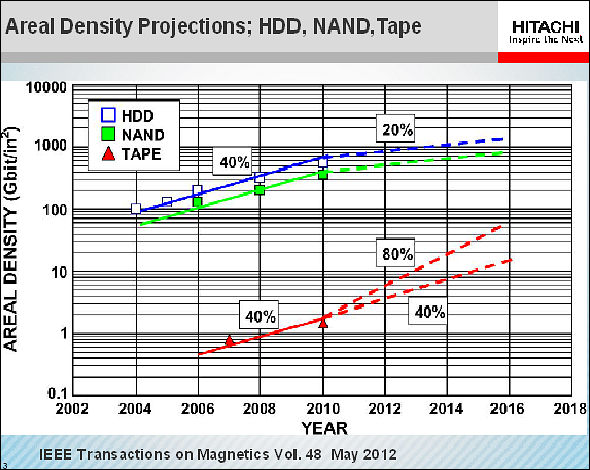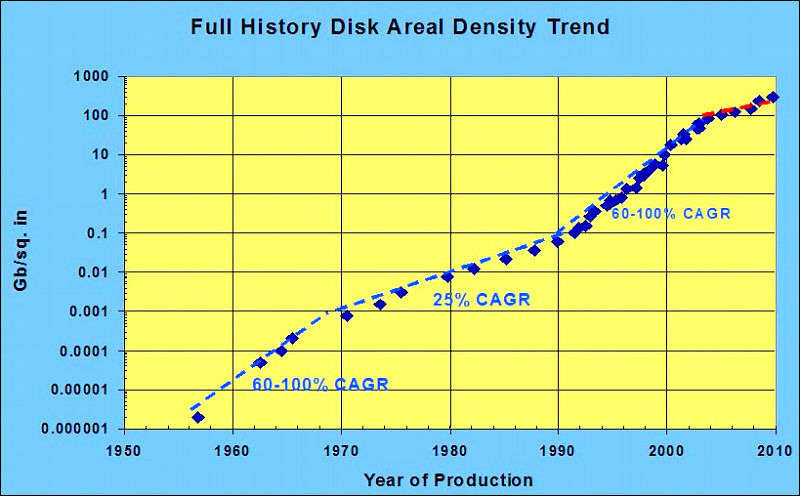
-
Below is a chart that was published in IEEE Transactions on Magnetics, which shows that the decline has been going on since 2010. This means that the price erosion of hard disk capacity, which has been about 30% for the past 50 years will slow down to less than 20% if we depend on bit densities. This reduction in price erosion will have a dramatic impact on the cost of storage unless we find other ways to reduce storage costs.


How to increase densities if performance is not a factor:
- Spin the disks slower and put more bits per track
- Use more of the recording surface
- Add more disks to the disk enclosure (Western Digital)
- Seal the enclosure in inert gases to add even more disks (Western Digital)
- Shingled recording where tracks are overlapped to increase track densities
- Combinations of bit pattern media and heat-assisted magnetic recording
Like:
Replacing regular air by helium gas inside hard disk drives is the next step to increase their capacity - not yet with better areal density - with the possibility to add more disk platters and heads into the same form factor.
The density of helium is seven times less than air, then reducing all mechanical frictions into the unit. Furthermore the oscillation of the rotating disks is reduced. Also there is a gain of energy of 45% in watt per terabyte or a reduced power consumption of 23%, a lower 4°C (7°F) temperature inside the box, and less noise (reduction of 0.9 bel in sleeping mode). Being a better conductor of heat than air, helium produces a more uniform temperature on the platters, protects the coating of the head and disk to lengthen the life of rotational drive, and allows a lower flying height for the heads. Less drag force acting on the spinning disk stack reduces mechanical power into the motor.
Consequently, it will be possible to push the number of platters from five - as it's the case for current 4TB 3.5-inch HDD from HGST - to seven, and to reach 5.6TB in the same volume and then at 7TB with 1TB platters. Maybe it could be more that in the future because tracks can be placed closer together, said HGST.
http://blogs.hds.com/hu/2013/02/hdds-and-nand-flash-will-be-around-for-some-time.html
If you carefully look around, progress in big capacity 3.5" HDD is very slow and small. And this is very bad.
We won't touch here SSDs and flash as it has bunch of other problems, some of them I already covered here.
-
fuck H.265 then!!! more HDD storage less price please
-
Do not really get the comment.
My post with charts just show that progress with HDD is slowing down and ALL of proposed improvements way lead to increased costs.
As for H.265, it will live happily, guys on torrents already started to use it :-)
Howdy, Stranger!
It looks like you're new here. If you want to get involved, click one of these buttons!
Categories
- Topics List23,992
- Blog5,725
- General and News1,354
- Hacks and Patches1,153
- ↳ Top Settings33
- ↳ Beginners256
- ↳ Archives402
- ↳ Hacks News and Development56
- Cameras2,367
- ↳ Panasonic995
- ↳ Canon118
- ↳ Sony156
- ↳ Nikon96
- ↳ Pentax and Samsung70
- ↳ Olympus and Fujifilm101
- ↳ Compacts and Camcorders300
- ↳ Smartphones for video97
- ↳ Pro Video Cameras191
- ↳ BlackMagic and other raw cameras116
- Skill1,960
- ↳ Business and distribution66
- ↳ Preparation, scripts and legal38
- ↳ Art149
- ↳ Import, Convert, Exporting291
- ↳ Editors191
- ↳ Effects and stunts115
- ↳ Color grading197
- ↳ Sound and Music280
- ↳ Lighting96
- ↳ Software and storage tips266
- Gear5,420
- ↳ Filters, Adapters, Matte boxes344
- ↳ Lenses1,582
- ↳ Follow focus and gears93
- ↳ Sound499
- ↳ Lighting gear314
- ↳ Camera movement230
- ↳ Gimbals and copters302
- ↳ Rigs and related stuff273
- ↳ Power solutions83
- ↳ Monitors and viewfinders340
- ↳ Tripods and fluid heads139
- ↳ Storage286
- ↳ Computers and studio gear560
- ↳ VR and 3D248
- Showcase1,859
- Marketplace2,834
- Offtopic1,320
Tags in Topic
- hdd 15




